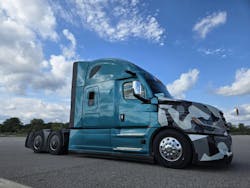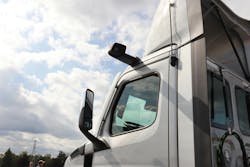Freightliner Cascadia Generation 5 takes safety, efficiency to next level
Daimler Truck North America has built more than 1 million Freightliner Cascadias since 2007, making it the most popular Class 8 truck in North America. And though the latest refresh, the Generation 5, only improves fuel efficiency by 1.9%, the engineering team has taken a huge leap in enhancing safety and uptime, specifically in the driver-assist technology and braking departments.
Advancement in sensor technology and computing power have enabled the Detroit Assurance Suite of Safety Systems to essentially “see” more of the road and (passively and actively) assist in avoiding collisions, while the new Intelligent Braking Control System incorporates brake-by-wire and pneumatic brakes to make deceleration smoother for the driver and gentler on the brake lining.
It’s a solid blend of road-tested technology sprinkled with the latest sensor and computing advancements to improve the driver experience and total cost of ownership during normal operation.
On the visibility front, factory-installed MirrorCam system (a version of the Stoneridge MirrorEye) and Dual Stage Intelligent LED Headlights will help drivers see better behind the wheel. Fleet managers also gets a better look at how those drivers perform via Detroit Connect Video Capture 2.0, and can review safety incidents to coach up drivers.
And new features such as remote door locking, unlocking and rollaway mitigation, and attentive driver protection (which can stop the vehicle if the driver is asleep of having a medical emergency) guard against the times when operation isn’t so normal.
In short, it’s a welcome cascade of innovation for an industry tasked to do more with less, and where an accident can lead to a debilitating lawsuit.
“Throughout the years, we've continued to be known for those innovations in the marketplace and by our customers,” explained Mary Aufdemberg, GM of product strategy and market development at DTNA, to industry press during an advanced reveal in Ypsilanti, Michigan, on October 1. “But what I love is we never innovate just to innovate. It's always with purpose, and it delivers something meaningful to our customers.”
Aufdemberg offered that’s a big reason why Freightliner owns a 40% market share in the on-highway market.
Though the latest innovations in aerodynamic—such as a sleeker hood, bumper air ducts, and two-piece hood-to-bumper seal—account for less than 2% better fuel efficiency, the steady flow of these innovations have led to a 35% improvement versus the Generation 1 Cascadia.
“The main focus of that 1.9%—really the sole focus—is all aerodynamic improvements,” explained Greg Treinen, DTNA VP of on-highway market development. “So there’s no new additions to the powertrain. From an efficiency perspective, it was all in with aerodynamics.”
The additions include:
- new aero hood
- redesigned A-pillar deflector,
- three-piece front wheel well closeouts,
- a hood-to-bumper seal,
- new bumper air ducts
- optional Max Aero Bumper
- Factory-installed MirrorCam system (Replacing traditional mirrors with this system also reduces drag)
Powertrain options
When the Gen 5 goes into production mid-2025, cusotmers can choose between the Detroit DD13 and DD15 engines, with ratings of up to 505 hp and 1,850 ft.-lb. of torque. The Cummins X15 and X15N, the first natural gas engine designed specifically for heavy-duty and on-highway truck applications, will be available for Cascadias built in 2026. They are available with 400 to 605 hp and 1,450 to 2,050 ft.-lb. of torque.
Advanced driver assistance systems
Overall, the updated Assurance systems include better computing power to go with an upgraded camera, four new short-range radar sensors, and an improved long-range radar sensor.
This new suite of sensor hardware enables the Cascadia’s updated safety offerings, including:
Active Brake Assist 6
Detroit’s ABA6 can now deploy automatic braking when detecting vehicles stopped at odd angles, vehicles in curves, and stopped vehicles across multiple lanes. While past ABA versions could recognize moving pedestrians, Daimler said it can now detect stationary pedestrians.
Active Lane Assist 2
Detroit’s ALA2’s new capabilities feature lane change assist, which can help reduce out-of-lane accidents by countersteering if the truck attempts to enter an already occupied lane.
Attentive Driver Protection
When ALA2’s lane-keeping assist is on and active, the truck monitors driver attention through steering wheel input and can initiate a sequence that keeps the Cascadia centered in its lane, slows the vehicle to a stop, and turns on the hazard lights if the driver is not responsive.
Side Guard Assist 2
SGA2 can now detect and warn drivers about objects on the truck’s driver and passenger sides, from the cab to the end of the trailer.
Intelligent Braking Control System
Cascadia’s new intelligent braking control system, or IBCS, combines brake-by-wire technology with backup pneumatics. It employs wheel speed sensors and a chassis-mounted electronic control unit to help create deceleration control.
DTNA also added comfort braking through the IBCS, which provides brake force distribution, lining wear control, and performance monitoring. These features ensure smoother, more confident braking—especially in sudden stops—and help elongate brake pad life through even wear.
Samantha Parlier, director of marketing communications at DTNA, noted that the using the air brake system alone will lead to a very abrupt stop, and the seatbelt can painfully press into your chest. The aptly named "Comfort Braking" delivers the air more precisely with the steer-by-wire system.
"It's softer and more accurate," Parlier said. "It keeps also the wheel-ends using the exact right amount of force, so the brake pad wear is going to be distributed, because one's not getting more air than the other."
Along with comfort braking, IBCS includes endurance braking, which blends the engine retarder and service brakes when the foot pedal is applied, helping to extend brake life further.
The all-new electronic park brake features rollaway mitigation, which automatically applies the parking brake if a driver leaves the seat or opens the door without setting the brake. DTNA engineers noted this feature will help prevent costly and dangerous rollaways.
Dual-stage intelligent LED headlights
New dual-stage intelligent LED headlights feature increased durability and impact resistance. Engineered to melt away ice and eliminate condensation in minutes, the LEDs have an increased beam pattern, an auto high beam feature, and easier beam adjustment capabilities to increase visibility, safety, and driver comfort.
Factory-installed MirrorCam system
The new Freightliner Cascadia offers a factory-installed MirrorCam System. This system uses definition in-cab screens connected to cameras mounted above the doors to provide a wide field of view that can replace traditional side-view mirrors. The camera system is equipped with infrared technology and hydrophobic coatings to repel water and other contaminants.
MirrorCam improves visibility, especially at night and during inclement weather, and driver comfort by minimizing head and neck movement. While federal regulations require DTNA to sell trucks with traditional mirrors, the Federal Motor Carrier Safety Administration can grant fleets waivers to remove them.
Daimler business intelligence built-in
To help improve uptime and furnish greater operational insights, the Cascadia is equipped with advanced technology that enables both new and familiar business intelligence tools.
The newest connected telematics platform, powering Detroit Connect, brings on-the-road benefits for drivers and more real-time information to fleet managers, according to DTNA. Additionally, a new electrical architecture enhances cybersecurity and enables faster processing speeds.
New key features of Detroit Connect include:
-
Detroit Connect Video Capture 2.0 automatically records and captures data during safety events or when initiated by a driver, providing fleet managers with remote access to valuable insights on driver behavior and potential risks. Videos are available near real time through an improved user interface within the Detroit Connect Portal.
-
Remote Lock and Unlock is a new feature derived directly from fleet manager feedback. It allows users to lock and unlock vehicles on demand, reducing roadside assistance costs and increasing vehicle uptime.
-
Geofencing allows customers to create custom-defined geographic areas in the Detroit Connect Portal and receive notifications when vehicles enter or leave that area.
-
Detroit Connect Safety Plus is a subscription service that allows fleet managers to remotely track and receive notifications about the status and health of Detroit Assurance safety systems.
-
Premium Remote Parameter Updates expands the number of parameters available for updates over the air from seven to more than 50.
About the Author
Josh Fisher
Technology Editor
Editor-in-Chief Josh Fisher has been with FleetOwner since 2017. He covers everything from modern fleet management to operational efficiency, artificial intelligence, autonomous trucking, alternative fuels and powertrains, regulations, and emerging transportation technology. Based in Maryland, he writes the Lane Shift Ahead column about the changing North American transportation landscape.

John Hitch
Editor-in-chief, Fleet Maintenance
John Hitch is the award-winning editor-in-chief of Fleet Maintenance, where his mission is to provide maintenance leaders and technicians with the the latest information on tools, strategies, and best practices to keep their fleets' commercial vehicles moving.
He is based out of Cleveland, Ohio, and has worked in the B2B journalism space for more than a decade. Hitch was previously senior editor for FleetOwner and before that was technology editor for IndustryWeek and and managing editor of New Equipment Digest.
Hitch graduated from Kent State University and was editor of the student magazine The Burr in 2009.
The former sonar technician served honorably aboard the fast-attack submarine USS Oklahoma City (SSN-723), where he participated in counter-drug ops, an under-ice expedition, and other missions he's not allowed to talk about for several more decades.

